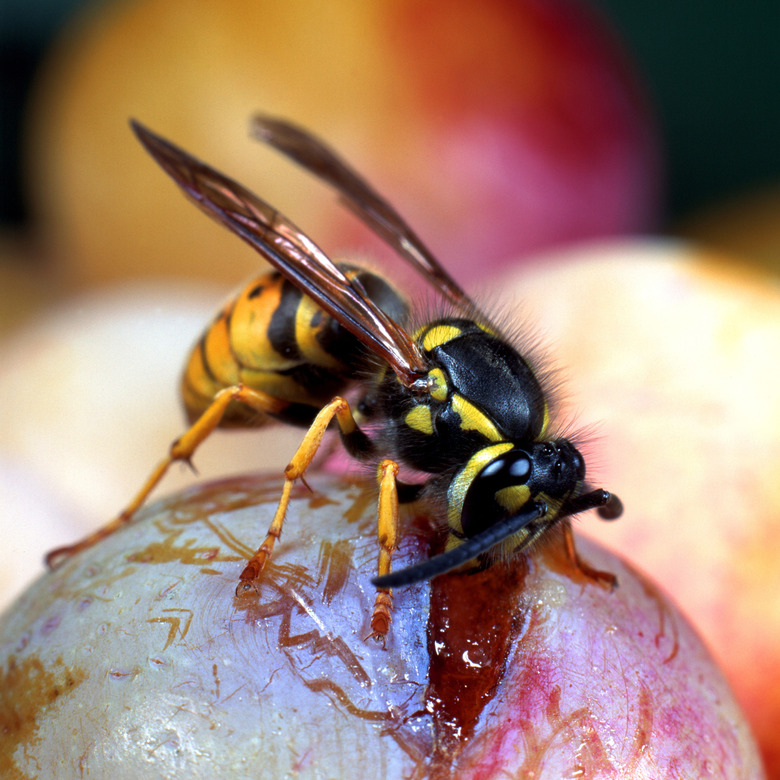How To Get Rid Of Yellow Jackets Under House Eaves
Things Needed
- Long-sleeved shirt
- Long pants
- Safety glasses
- Hat
- Gloves
- Ladder (if needed)
- Flashlight
- Wasp & hornet spray (containing pyrethrin)
Yellow jackets are a member of the wasp family and are one of the most aggressive species found in North America. Yellow jackets are mainly yellow in color, with black stripes covering most of their body. The average yellow jacket adult is usually less than an inch in length and is only slightly larger than a house fly. Though yellow jackets normally prefer to burrow into the ground to make their nests, they will makes nests in walls and eaves of homes, especially if the location is near an area in which they forage for food. Locations near trash cans are also attractive to the yellow jacket.
Step 1
Find the exact location of the nest. If the nest is between the eaves of your home, you may have to use a ladder to see between the slats. Observe yellow jacket activity, watch where they land and crawl through the eave slats. This may the location of the nest.
- Yellow jackets are a member of the wasp family and are one of the most aggressive species found in North America.
- Though yellow jackets normally prefer to burrow into the ground to make their nests, they will makes nests in walls and eaves of homes, especially if the location is near an area in which they forage for food.
Step 2
Pinpoint the location of the nest after dark and treat it with insecticide spray. Yellow jackets are dormant at night, and all of the wasps will return to the nest at dusk to sleep. Treating the nest after the sun goes down ensures they will be asleep, and you will be much less likely to be stung.
Step 3
Put on long pants, a long-sleeve shirt, a hat, safety glasses and gloves. Cover as much exposed skin as you can in case you awaken the yellow jackets before you can treat the nest.
Step 4
Position the ladder under the eaves. Slowly climb the ladder. Shine a flashlight between the slats to find the exact position of the nest. The nest will look like a regular paper wasp nest, with individual cells, and it will be gray. Once you find the nest, back away from the nest before you treat it with the insecticide spray.
- Pinpoint the location of the nest after dark and treat it with insecticide spray.
- Yellow jackets are dormant at night, and all of the wasps will return to the nest at dusk to sleep.
Step 5
Soak the nest with wasp and hornet insecticide spray (pyrethrin). Avoid standing directly under the nest while you spray it or else insecticide and angry yellow jackets may rain down on you. Use the entire can of spray and go inside immediately. The yellow jackets will come flying out of the nest, but most or all of them will die if you thoroughly sprayed the nest.
Step 6
Check the nest in the morning for any yellow jacket activity. If you see any of the wasps flying to the nest area, treat the nest again that night. If no yellow jackets are observed, you can remove the nest.
- Soak the nest with wasp and hornet insecticide spray (pyrethrin).
- If you see any of the wasps flying to the nest area, treat the nest again that night.
Step 7
Poke a stick or a kite stick through the slats of the eaves and knock the nest free. Dispose of the nest.
References
- University of Kentucky Extension; Foraging Yellow Jackets; Michael F. Potter; October 1996
- North Carolina State Universiy Extension; Controlling Bald Faced Hornets and Yellow Jackets in and Around Structures; Stephen B. Bambara, et al.; Dec. 29, 1999
- University of Kentucky Extension; Controlling Wasps, Hornets and Yellow Jackets; Michael F. Potter; January 1994
